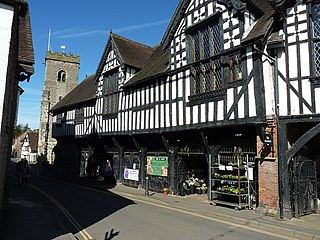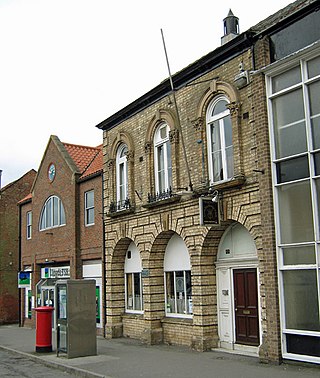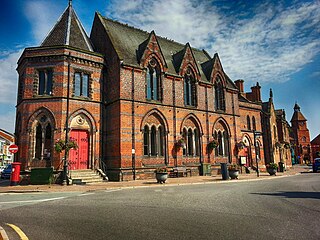
Shropshire is a landlocked ceremonial county in the West Midlands of England. It borders Cheshire to the north, Staffordshire to the east, Worcestershire to the southeast, Herefordshire to the south, and the Welsh counties of Wrexham and Powys to the west. The largest settlement is Telford (155,570), and Shrewsbury (76,782) is the county town.

Wellington is a constituent market town of Telford and a civil parish in the borough of Telford and Wrekin, Shropshire, England. It is situated 2.5 miles (4.0 km) northwest of Telford town centre and 12 miles (19 km) east of Shrewsbury. The summit of The Wrekin lies 3 miles southwest of the town. The population of the town was 25,554 in 2011. It also has good bus services making it one of the most accessible towns in Shropshire.

Much Wenlock is a market town and parish in Shropshire, England, situated on the A458 road between Shrewsbury and Bridgnorth. Nearby, to the northeast, is the Ironbridge Gorge and Telford. The civil parish includes the villages of Homer, Wyke, Atterley, Stretton Westwood and Bourton. The population of the civil parish, according to the 2001 census, was 2,605, increasing to 2,877 at the 2011 Census.

The Wenlock Olympian Games, dating from 1850, are a forerunner of the modern Olympic Games. They are organised by the Wenlock Olympian Society (WOS), and are held each year at venues across Shropshire, England, centred on the little market town of Much Wenlock. One of the two mascots for the 2012 Summer Olympics was named Wenlock in honour of the Wenlock Olympian Games.

Orlando George Charles Bridgeman, 3rd Earl of Bradford, PC, DL, styled Viscount Newport between 1825 and 1865, was a British courtier and Conservative politician. In a ministerial career spanning over thirty years, he notably served as Lord Chamberlain of the Household between 1866 and 1868 and as Master of the Horse between 1874 and 1880 and again between 1885 and 1886.

The Corn Exchange is an events and concert venue located on Wheeler Street in Cambridge, Cambridgeshire, England. The structure, which was commissioned as a corn exchange, is a Grade II listed building.

A corn exchange is a building where merchants trade grains. The word "corn" in British English denotes all cereal grains, such as wheat and barley; in the United States these buildings were called grain exchange. Such trade was common in towns and cities across England until the 19th century, but as the trade became centralised in the 20th century many such buildings were used for other purposes. Several have since become historical landmarks.

Cecil Theodore Weld-Forester, 5th Baron Forester, was a British peer and Conservative Member of Parliament, styled The Honourable from 1886 to 1894.

William Penny Brookes was an English surgeon, magistrate, botanist, and educationalist especially known for founding the Wenlock Olympian Games, inspiring the modern Olympic Games, and for his promotion of physical education and personal betterment.

Leicester Corn Exchange is a commercial building in the Market Place in Leicester, Leicestershire, England. The structure, which currently operates as a public house, is a grade II* listed building.

Rushbury is a village and civil parish in Shropshire, roughly five miles from Church Stretton and eight miles from Much Wenlock.

Stanley Leighton was an English barrister, landowner, artist and Conservative politician. He is also known as an antiquarian and author.

The Much Wenlock Guildhall is a guildhall located on Wilmore Street in Much Wenlock, Shropshire. It is a Grade II* listed building.

The original Much Wenlock railway station was opened 1 February 1862 by the Much Wenlock and Severn Junction Railway, linking Buildwas with Much Wenlock. The line later formed part of the Wellington to Craven Arms Railway and was, for much of its working life, operated by the Great Western Railway.
William Brookes School is a mixed secondary school and sixth form located in Much Wenlock in the English county of Shropshire. The school is named after William Penny Brookes, a surgeon, magistrate, botanist, and educationalist from Much Wenlock especially known for inspiring the modern Olympic Games with the Wenlock Olympian Games. The school serves a community of small villages as well as the larger town of Broseley.

Corn exchanges are distinct buildings which were originally created as a venue for corn merchants to meet and arrange pricing with farmers for the sale of wheat, barley, and other corn crops. The word "corn" in British English denotes all cereal grains, such as wheat and barley. With the repeal of the Corn Laws in 1846, a large number of corn exchanges were built in England, particularly in the corn-growing areas of Eastern England.

The Corn Exchange is a commercial building on Fore Street in Hertford, Hertfordshire, England. The structure, which is currently used as an events venue, is a Grade II listed building.

The Corn Exchange is a commercial building in the Market Place in Barton-upon-Humber, Lincolnshire, England. The structure, which is now used as a private members club, is a Grade II listed building.

The Corn Exchange is a commercial building in the High Street in Ross-on-Wye, Herefordshire, England. The structure, which is now used as a bookshop and as the offices of Ross-on-Wye Town Council, is a Grade II listed building.

The Sandbach Literary Institute, also known as Sandbach Literary Institution is a commercial building in Hightown in Sandbach, Cheshire, England. The structure, which is currently used as a community events venue, is a Grade II listed building.





















